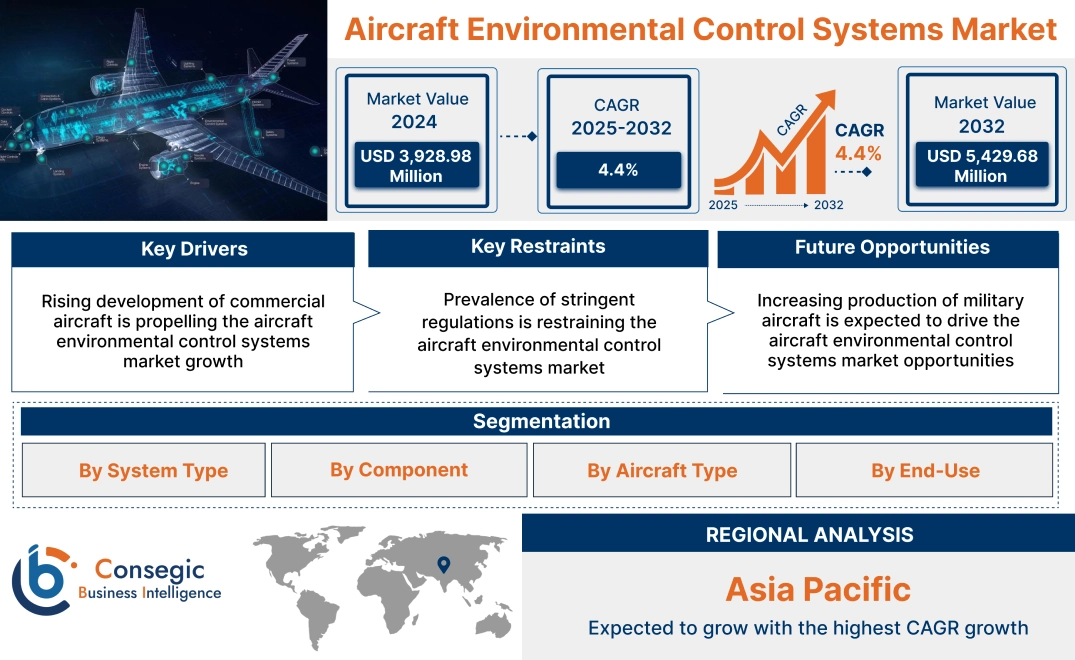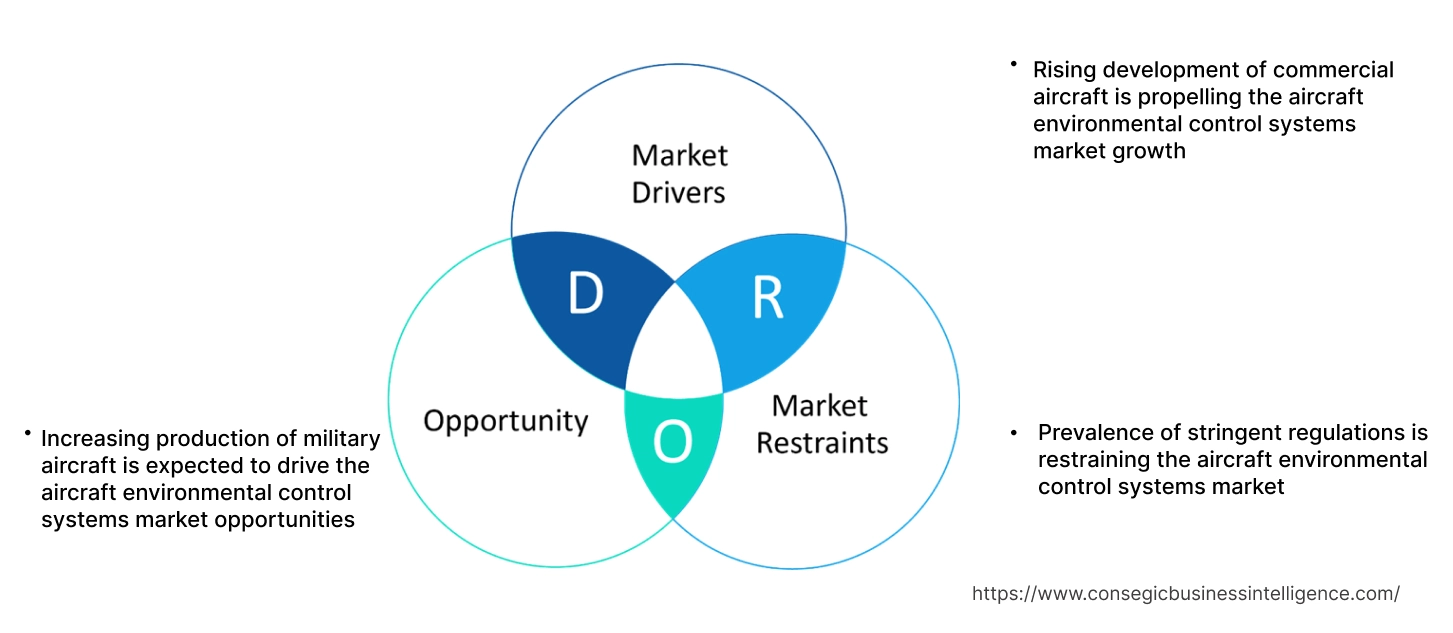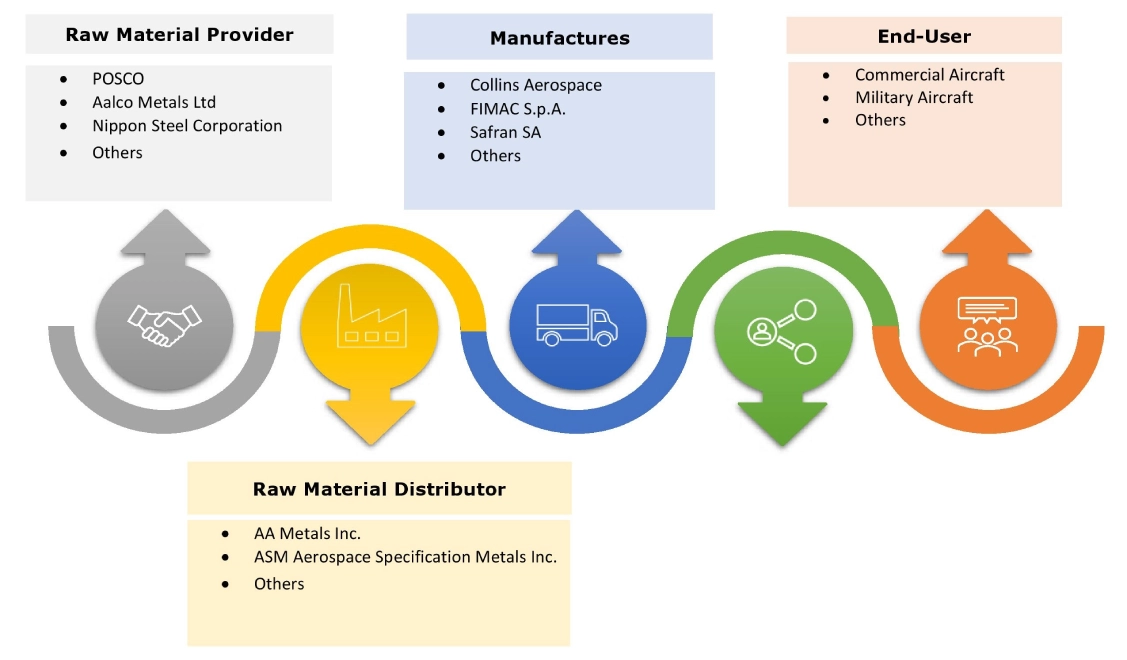- Summary
- Table Of Content
- Methodology
Aircraft Environmental Control Systems Market Size:
Aircraft Environmental Control Systems Market size is estimated to reach over USD 5,429.68 Million by 2032 from a value of USD 3,928.98 Million in 2024 and is projected to grow by USD 4,032.71 Million in 2025, growing at a CAGR of 4.4% from 2025 to 2032.
Aircraft Environmental Control Systems Market Scope & Overview:
Aircraft environmental control systems (ECS) are crucial systems in aircraft that are designed to maintain a suitable environment for passengers and crew throughout the flight. These systems are responsible for regulating temperature, humidity, and air pressure inside the cabin, ensuring comfort and safety. ECS typically includes components for air supply, air conditioning, cabin pressurization, and ventilation. Moreover, an environmental control system provides a range of benefits such as increased passenger comfort, performance optimization, operational flexibility, and others.
Key Drivers:
Rising development of commercial aircraft is propelling the aircraft environmental control systems market growth
Aircraft environmental control systems play a crucial role in the commercial aviation sector. In commercial aircraft, environmental control systems are primarily used for a range of functionalities including improved temperature control, maintaining in-cabin pressurization, air quality management, humidity control, and improved ventilation among others. Moreover, environmental control systems enhance the passenger experience by providing a controlled and comfortable environment, which is essential for long-haul commercial flights.
- For instance, Airbus, a European aircraft manufacturer, delivered 735 commercial aircraft in 2022, depicting an increase of approximately 11% in comparison to 661 deliverables in 2022.
Hence, the rising development of commercial aircraft is increasing the adoption of environmental control systems for maintaining a suitable environment for passengers and crew within the aircraft, in turn proliferating the aircraft environmental control systems market size.
Key Restraints:
Prevalence of stringent regulations is restraining the aircraft environmental control systems market
The manufacturers of aircraft environmental control systems have to comply with numerous stringent standards such as ISO (International Organization for Standardization) Standard - ISO 9001, SAE Aerospace Standard (AS) - SAE, ASTM F3227/F3227M-22, and others, which is a primary factor constraining the market growth.
For instance, the ISO 9001 standard specifies particular requirements for a quality management system. Aircraft environmental control systems manufacturers must comply with the ISO standard to demonstrate the ability to consistently provide products and services that meet regulatory and customer requirements. Additionally, the SAE standard refers to an aerospace standard that governs the design and manufacturing of environment control systems for unmanned aircraft.
Further, ASTM F3227/F3227M-22 specification covers international standards for environmental system aspects and design for small aircraft. Therefore, the prevalence of the aforementioned regulations and standards associated with manufacturing environmental control systems is hindering the aircraft environmental control systems market expansion.
Future Opportunities :
Increasing production of military aircraft is expected to drive the aircraft environmental control systems market opportunities
Aircraft environmental control systems are often used in military aircraft to maintain cabin pressurization, temperature and humidity control, and air quality management among others, to ensure military personnel safety and comfort. Military aircraft need to maintain a pressurized cabin to ensure the safety and effectiveness of personnel at high altitudes, particularly in fast-moving tactical aircraft that operate above normal flight levels. ECS also regulates cabin temperature and humidity, which is vital for the comfort and operational capability of personnel in the cockpit and cabin.
- For instance, Dassault Aviation, a French manufacturer of business jets and military aircraft, launched its new Rafale fighter aircraft in December 2022. The military aircraft was designed for deployment in the Directorate General of Armaments, a France-based military procurement agency.
Thus, as per the analysis, the rising production of military aircraft is projected to increase the demand for environmental control systems for maintaining cabin pressurization, temperature and humidity control, and air quality management among others, to ensure military personnel safety and comfort. The above factors are expected to boost the aircraft environmental control systems market opportunities during the forecast period.
Aircraft Environmental Control Systems Market Segmental Analysis :
By System Type:
Based on system type, the market is segmented into air supply & management systems, thermal management & control systems, cabin pressure & control systems, and others.
Trends in the System Type:
- Increasing adoption of air supply & management system due to its several benefits including enhanced passenger comfort, improved air quality and humidity levels, and others.
- Rising trend towards utilization of cabin pressure & control systems for maintaining and regulating the pressure within the aircraft cabin.
The air supply & management system segment accounted for the largest revenue share of 34.79% in the total aircraft environmental control systems market share in 2024.
- The air supply & management system is responsible for supplying, regulating, and distributing air within the cabin and various other compartments of the aircraft.
- Aircraft air supply & management system ensures a continuous supply of fresh air, manages cabin pressure and maintains appropriate air quality, and humidity levels throughout the flight.
- Moreover, the aircraft air supply & management system utilizes bleed air from engines (high-pressure air taken from the compressor stage of aircraft engines) to provide fresh air to the cabin and cockpit.
- For instance, Liebherr is an environmental control system manufacturer that offers air management systems in its product offerings. Liebherr develops all aircraft and engine air systems, including engine bleed air ports, engine pneumatics, air distribution units, and others.
- According to the analysis, the rising advancements associated with aircraft air supply & management systems are driving the market.
The cabin pressure & control system segment is anticipated to register a significant CAGR growth during the forecast period.
- Aircraft cabin pressure and control systems are responsible for maintaining and regulating the pressure within the aircraft cabin.
- Cabin pressure and control system ensure that the cabin pressure is maintained at safe and comfortable levels, regardless of the actual altitude at which the aircraft is flying.
- Moreover, the cabin pressure and control system constantly monitors the cabin pressure and makes adjustments as necessary to ensure crew and passenger comfort.
- For instance, in January 2021, Honeywell launched its next generation of cabin pressure control and monitoring systems. The system is designed for application in both military and commercial aircraft.
- Thus, increasing innovations related to cabin pressure and control systems are anticipated to drive the market during the forecast period.
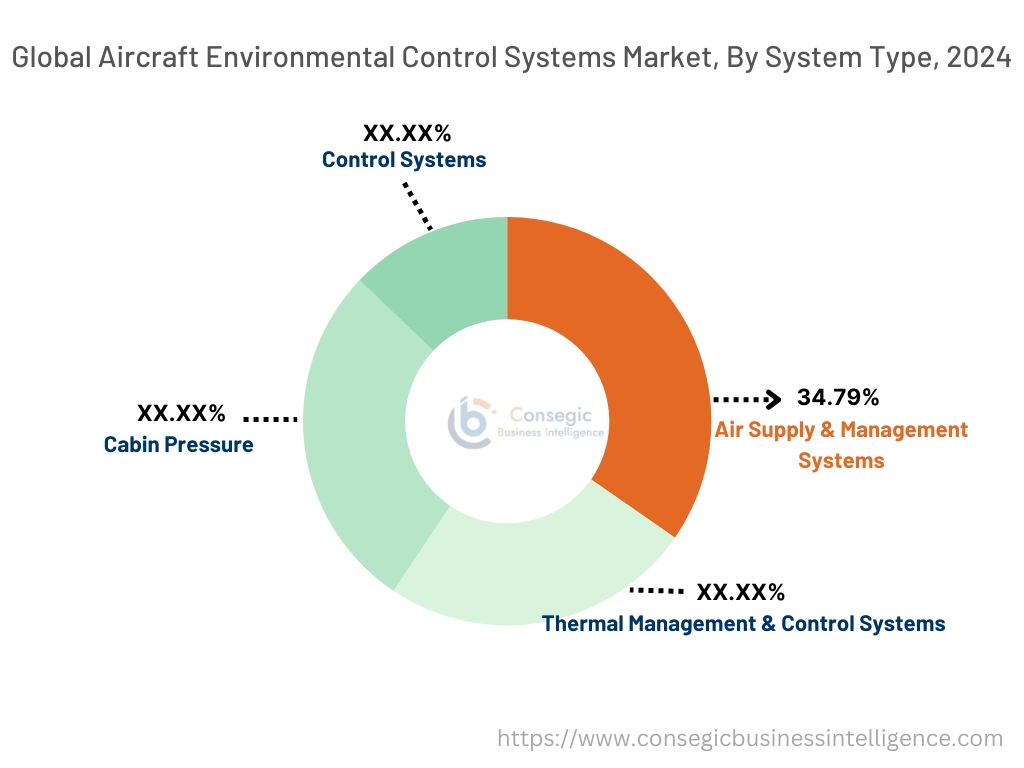
By Component:
Based on components, the market is segmented into heat exchangers, evaporators, water separators, compressors, and others.
Trends in the Component:
- Increasing advancements associated with heat exchangers and compressors for application in commercial and military aircraft.
- There is a rising trend towards the adoption of heat exchangers to regulate the temperature of the air circulated throughout the aircraft cabin and cockpit.
The heat exchanger segment accounted for the largest revenue in the overall market in 2024, and it is anticipated to register a significant CAGR growth during the forecast period.
- An aircraft heat exchanger refers to a component of an aircraft's environmental control system that helps to regulate the temperature of the air circulated throughout the cabin and cockpit.
- The heat exchanger works by transferring heat between two fluids to regulate the temperature of the air entering the cabin.
- The heat exchanger mainly consists of a series of tubes or plates that allow the hot and cool fluids to flow in opposite directions without coming into direct contact with each other. As the fluids flow through the heat exchanger, heat is transmitted from the hot fluid to the cooler fluid, reducing the temperature of the hot fluid and increasing the temperature of the cooler fluid.
- For instance, in June 2023, Safran launched its new HIPEX model of heat exchangers. The heat exchangers feature a curved and adjustable shape, and ease of integration, along with a compact, more aerodynamic, and optimized design.
- According to the aircraft environmental control systems market analysis, the rising innovations associated with aircraft heat exchangers are driving the aircraft environmental control systems market growth.
By Aircraft Type:
Based on aircraft type, the market is segmented into fixed-wing and rotary-wing.
Trends in the aircraft type:
- Increasing adoption of fixed-wing aircraft, attributing to its higher speed capabilities, longer flight range, and, greater payload capacity.
- Factors such as rising investments in air defense platforms and technological advancements in aircraft manufacturing are major determinants for driving the segmental growth of fixed-wing and rotary-wing aircraft.
The fixed-wing segment accounted for the largest revenue in the overall aircraft environmental control systems market share in 2024.
- Fixed-wing aircraft refers to a type of aircraft with wings that remain stationary while generating the aircraft's lift.
- Fixed-wing aircraft is capable of flight using wings that produce lift generated by the aircraft's forward airspeed and the shape of the wings.
- Moreover, fixed-wing aircraft offers a range of benefits including higher speed capabilities, longer flight range and endurance, greater payload capacity, improved stability in turbulent weather conditions, along with relatively lower maintenance and operational costs among others.
- For instance, in November 2022, Aurora Flight Sciences launched its new fixed-wing eVTOL (electric vertical take-off and landing) aircraft that is specifically designed for airborne ISR (intelligence, surveillance, and reconnaissance) missions.
- Therefore, increasing advancements associated with fixed-wing aircraft are driving the aircraft environmental control systems market trends.
The rotary wing segment is anticipated to register a substantial CAGR growth during the forecast period.
- Rotary wing aircraft is a type of aircraft that is completely or partly sustained in the air by lifting rotors revolving around a vertical axis.
- Rotary wing aircraft typically include aircraft that consists of rotors that provide lift throughout the entire flight, such as helicopters, gyrodynes, and autogyros.
- Additionally, the primary benefits of rotary-wing aircraft include its ability to fly vertically, hover over a fixed position at a given height, and take off and land in a very small space.
- For instance, in December 2021, the French Armament General Directorate collaborated with Airbus for the procurement and development of military helicopters. The contract includes the development of 169 military helicopters specifically optimized for deployment in the French armed forces.
- Hence, the increasing development of rotary-wing aircraft is anticipated to boost the market during the forecast period.
By End-Use:
Based on the end-user, the market is segmented into commercial, military & defense, and others.
Trends in the End-Use:
- Factors including rising air travel trends, growing commercial flight activities, and increasing production of commercial aircrafts are key factors fueling the commercial segment.
- Rising technological advancements in air defense systems, increasing government investments in airborne defense platforms, and the growing need for advanced military aircraft for enhancement of aerial defense capabilities are primary trends driving the military & defense segment.
The commercial segment accounted for the largest revenue share in the total market share in 2024.
- This dominance is attributed to the rising adoption of ECS in commercial aircraft for maintaining a suitable environment for passengers and crew within the aircraft.
- Moreover, environmental control systems enhance passenger experience by providing a controlled and comfortable environment, which is essential for long-haul commercial flights.
- For instance, Airbus delivered 14,950 commercial aircrafts as of September 2023, which includes 11,370 single-aisle aircrafts and 3,580 wide body aircrafts.
- According to the analysis, the rising production of commercial aircraft is driving the aircraft environmental control systems market size.
Military & defense segment is anticipated to register a significant CAGR during the forecast period.
- Aircraft environmental control systems are often used in military aircraft to maintain cabin pressurization, temperature and humidity control, and air quality management among others, to ensure military personnel safety and comfort.
- Moreover, the aircraft environment control system also regulates cabin temperature and humidity, which is vital for the comfort and operational capability of personnel in the cockpit and cabin.
- For instance, in 2023, Shaanxi Aircraft Corporation introduced its new and enhanced special mission aircraft that is optimized for airborne early warning and control operation.
- Therefore, the increasing development of military aircraft is expected to drive the demand for aircraft ECS, in turn propelling the market during the forecast period.
Regional Analysis:
The regions covered are North America, Europe, Asia Pacific, the Middle East and Africa, and Latin America.
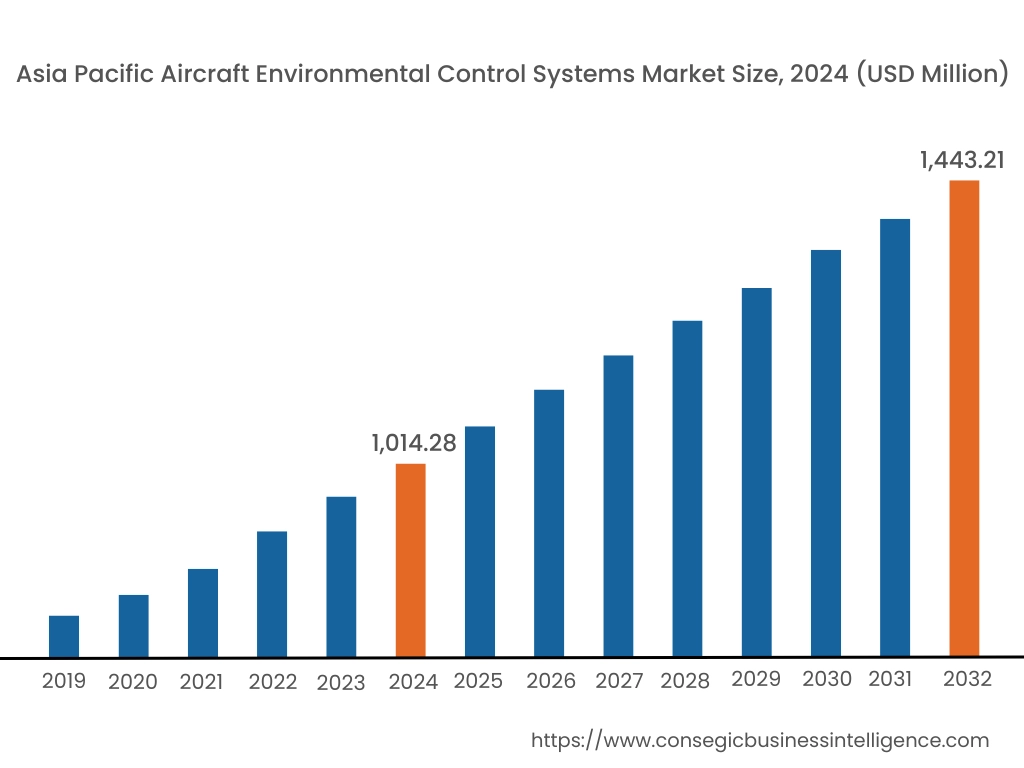
Asia Pacific region was valued at USD 1,014.28 Million in 2024. Moreover, it is projected to grow by USD 1,043.63 Million in 2025 and reach over USD 1,443.21 Million by 2032. Out of this, China accounted for the maximum revenue share of 33.8%. As per the aircraft environmental control systems market analysis, the adoption of environmental control systems in the Asia-Pacific region is primarily driven by the increasing production from the aerospace & defense industry and rising investments in military aircraft among others. Additionally, the rising aircraft production is further accelerating the aircraft environmental control systems market expansion.
- For instance, in October 2022, Tata Advanced Systems Limited launched its new C-295 transport aircraft manufacturing facility in Gujarat, India in collaboration with Airbus. The manufacturing facility is responsible for the delivery of C-295 transport aircraft to the Indian Air Force. The above factors are driving the adoption of aircraft environment control systems, in turn propelling the market in the Asia-Pacific region.
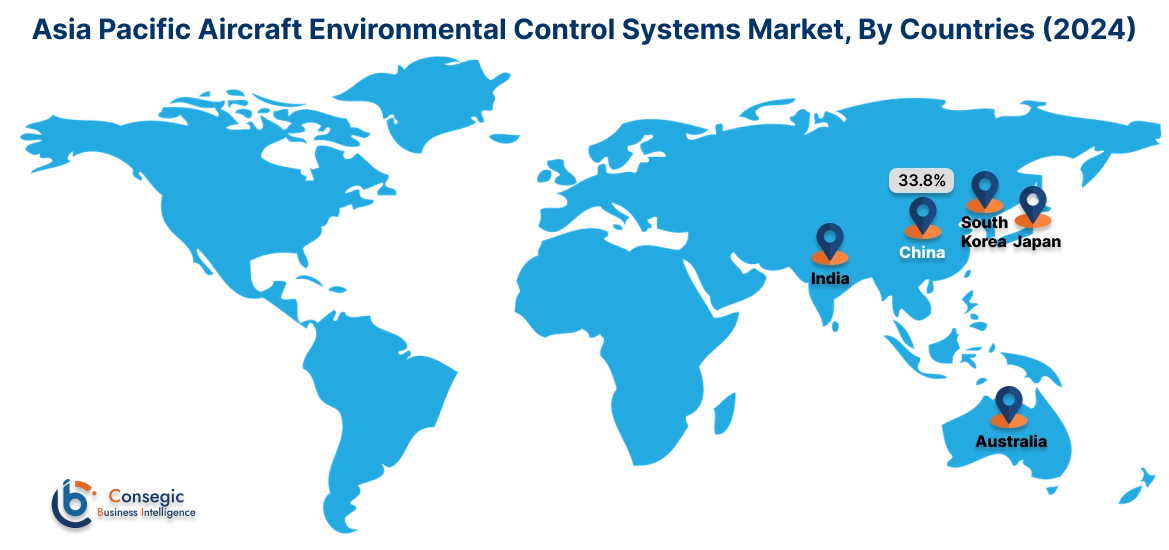
North America is estimated to reach over USD 1,930.25 Million by 2032 from a value of USD 1,399.07 Million in 2024 and is projected to grow by USD 1,435.80 Million in 2025. In North America, the growth of the aircraft environmental control systems industry is driven by the growing commercial aviation and defense sectors. Similarly, the rising development of commercial aircraft is contributing to the aircraft environmental control systems market demand.
- For instance, Boeing, a U.S-based aerospace company, delivered approximately 136 commercial aircraft during the second quarter of 2023, depicting an increase of 4.6% in comparison to 130 commercial aircraft deliverables during the first quarter of 2023. The rising commercial aircraft deliverables are projected to drive the aircraft environmental control systems market trends in North America during the forecast period.
The regional analysis depicts that the rising production of military and commercial aircrafts is driving the aircraft environmental control systems market demand in Europe. Furthermore, as per the market analysis, the market demand in Latin America, the Middle East, and African regions is expected to grow at a considerable rate due to factors such as the growing aerospace & defense industry and increasing investments in aircraft production among others.
Top Key Players and Market Share Insights:
The global aircraft environmental control systems market is highly competitive with major players providing services to the national and international markets. Key players are adopting several strategies in research and development (R&D), product innovation, and end-user launches to hold a strong position in the aircraft environmental control systems market. Key players in the aircraft environmental control systems industry include-
- Honeywell International Inc. (U.S.)
- FIMAC S.p.A. (Italy)
- Omni Aerospace Inc. (U.S.)
- PBS Aerospace (U.S.)
- Triumph Group (U.S.)
- Safran SA (France)
- Techno Aerospace (U.S.)
- Collins Aerospace (U.S.)
- Liebherr (Switzerland)
- Mecaer Aviation Group (Italy)
Recent Industry Developments :
Product Launches:
- In June 2023, Intergalactic launched its new thermal management system that is designed to cool the cabin and batteries of eVTOL and other types of electric aircraft.
- In January 2021, Honeywell launched its next generation of cabin pressure control and monitoring systems. The system is designed for application in both military and commercial aircraft.
Aircraft Environmental Control Systems Market Report Insights :
| Report Attributes | Report Details |
| Study Timeline | 2019-2032 |
| Market Size in 2032 | USD 5,429.68 Million |
| CAGR (2025-2032) | 4.4% |
| By System Type |
|
| By Component |
|
| By Aircraft Type |
|
| By End-Use |
|
| By Region |
|
| Key Players |
|
| North America | U.S. Canada Mexico |
| Europe | U.K. Germany France Spain Italy Russia Benelux Rest of Europe |
| APAC | China South Korea Japan India Australia ASEAN Rest of Asia-Pacific |
| Middle East and Africa | GCC Turkey South Africa Rest of MEA |
| LATAM | Brazil Argentina Chile Rest of LATAM |
| Report Coverage |
|
Key Questions Answered in the Report
How big is the aircraft environmental control systems market? +
The aircraft environmental control systems market was valued at USD 3,928.98 Million in 2024 and is projected to grow to USD 5,429.68 Million by 2032.
Which is the fastest-growing region in the aircraft environmental control systems market? +
Asia-Pacific is the region experiencing the most rapid growth in the aircraft environmental control systems market.
What specific segmentation details are covered in the aircraft environmental control systems report? +
The aircraft environmental control systems report includes specific segmentation details for the system type, component, aircraft type, end-use, and region.
Who are the major players in the aircraft environmental control systems market? +
The key participants in the aircraft environmental control systems market are Honeywell International Inc. (U.S.), FIMAC S.p.A. (Italy), Safran SA (France), Techno Aerospace (U.S.), Collins Aerospace (U.S.), Liebherr (Switzerland), Mecaer Aviation Group (Italy), Omni Aerospace Inc. (U.S.), PBS Aerospace (U.S.), and Triumph Group (U.S.).
